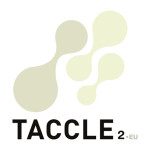8-12yrs Ease *
Overview: Learners investigate how to improve the composition of photographs and to understand which are the main aesthetic rules of composition through a digital analysis of the most famous images of statues, paintings and photos by some of the most important artists in history. With the aid of a computer you can easily view the imaginary construction lines that an artists has utilised in order to create effective pieces of art. All this can be analysed through the various types of compositions, as this example shows
http://photoinf.com/General/Arnold_Kaplan/The_Magic_Of_Selective_Vision_-_Photo_Composition.htm
The rectangle in the frame is theoretically divided into two triangles by a diagonal. Usually one triangle is darker than the other. Usually, along the diagonal, you can detect two major points of interest. The composition on the diagonal necessitates an angled shot in respect to the object. It is a way of composing that is more classical and elegant. It is a type of composition that is often neglected, because many of us prefer frontal filming points:
http://digital-photography-school.com/using-diagonal-lines-in-photography
Triangle Composition:
From the composition of the objects and lines, it is not hard to perceive a triangle composition that leans firmly on the base. Very stable composition, which is well adapted to static subjects inspire an impression of peace, as in classical compositions of portraits, where the head represents one of the top levels of the triangle:
http://www.thedphoto.com/photography-techniques/photography-composition-tip-enforce-order-through-triangles/
Circular composition:
All elements are arranged around a point of interest, as to form a crown. This is often used to photograph scenery where a series of scenes, in close up, surround the main subject:
http://chestofbooks.com/arts/photography/Photographics-Lessons/64-Circular-Composition.html
Radiant composition:
From a principal point lines branch out bringing to a series of significant details which are fthen framed in the resulting shot
Rule of thirds
According to this rule there should be “ideally” an overlapping of the reticle composed of two vertical lines and two horizontal (strength lines), equidistant to each other and the borders of the image. The image is then divided into nine sections all the same: the central square is named the golden section and is defined by four intersection points of the lines (strength points, focal points or focus). These are the points where the eye is mainly concentrated after having “looked” at the center of the image and from where you collect most of the information:
http://digital-photography-school.com/rule-of-thirds
In order to make the image more dynamic the object must be placed on the strength lines of the image (usually the vertical ones) or more precisely on the focal points of the shot; the decentralized position emphasising the importance of the object. The horizontal force lines, in the composition of landscaping photography, are used as reference in order to position the horizon and the perspective. Furthermore the diagonal ones which pass as two opposite points of interest could be used as guidelines. The rule of the third is applicable to every type of format and can therefore be even square or scenic whenever it is possible to divide the image in to thirds with strength lines.
The rule of thirds and the golden ratio are some of the main aesthetic rules that nature used in order to create the biggest work of art ever – the Universe.
In a second phase of post-production the snap shots will be analysed to correct, if necessary, the compositions.
Description:
The teacher together with the students analyses how the composition rules are observed in each of the works examined (show examples). The students analyze several reproductions, measuring, comparing, overlapping and “dismantling” the various works in order to see the differences, the similarities, singularities and the repeated parts in order to understand the main aesthetic rules and how mathematics can be applied to areas that are, apparently, unrelated to science.
As a matter of fact, nature uses even rigid math rules in order to connect in a single structure all its creations.
As examples we can use Fibonacci Theories:
http://my-ecoach.com/online/webresourcelist.php?rlid=4277
Or the idea that brought the Scottish naturalist D’Arcy Wentworth Thompson (1860-1948) to a mathematics study of the nature of species:
http://www.darcythompson.org/about.html
The students should be asked to analyze natural elements in order to understand if the rules are similar or completely different. Once this concept has been acquired, the activity entails going around to take pictures and then analyse their own pictures with and image editing software and make improvements where necessary according to the different composition rules.
What do I need?
PC, Wiki, image editing software (e.g. http://www.gimp.org/ or pixlr.com), digital cameras.
Added value:
Learners create effective digital images and compositions and begin to understand the mathematical rules of aesthetics.
Hints and tips:
Suitable explanation of the golden section will need to be given depending on the age of learners. This exercise allows us to apply these rules concretely using the images from the world around us.
Safety: There are no safety issues relating to this activity.




 English
English Nederlands
Nederlands Deutsch
Deutsch Italiano
Italiano Español
Español Português
Português Română
Română Cymraeg
Cymraeg
No comments yet.